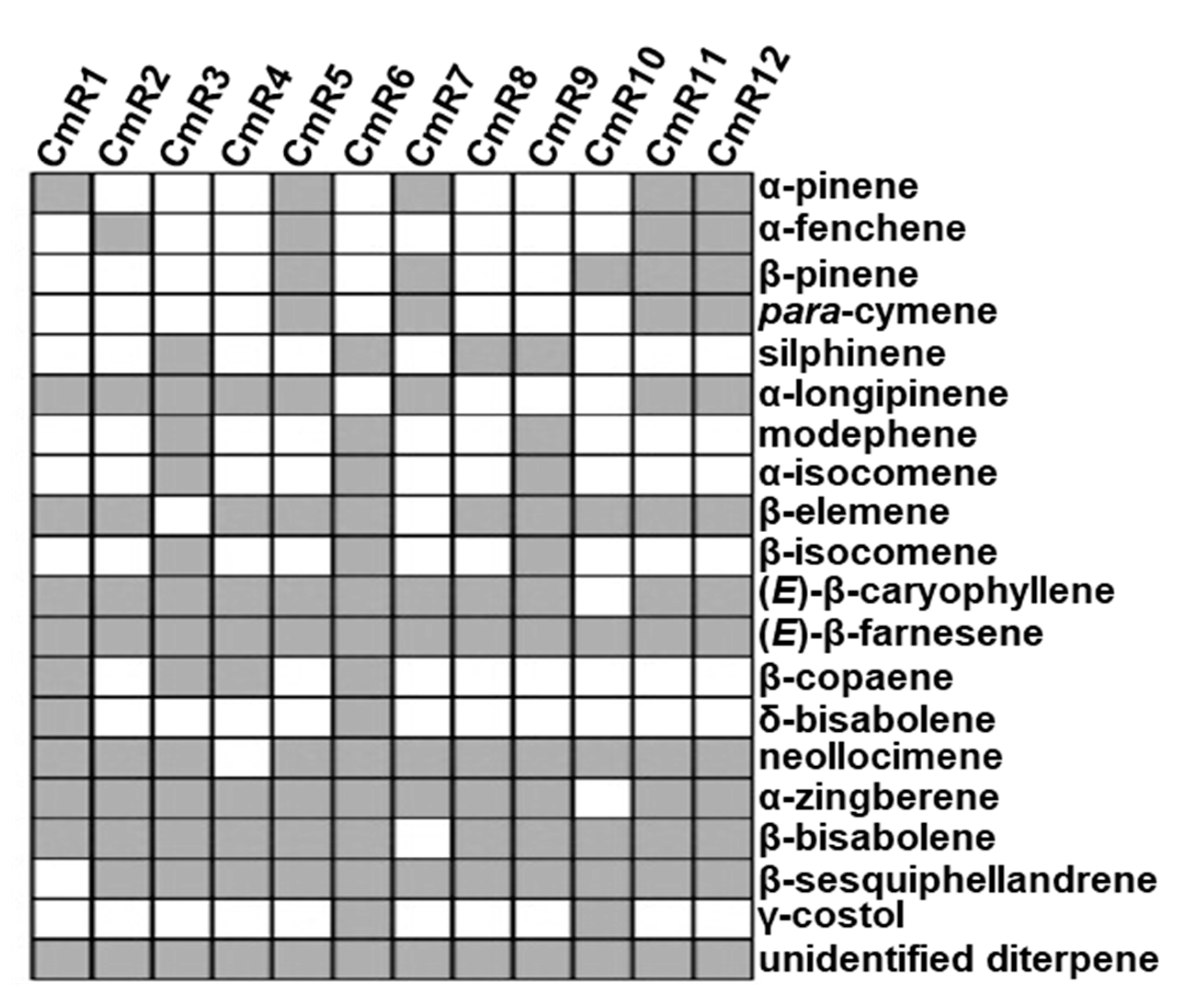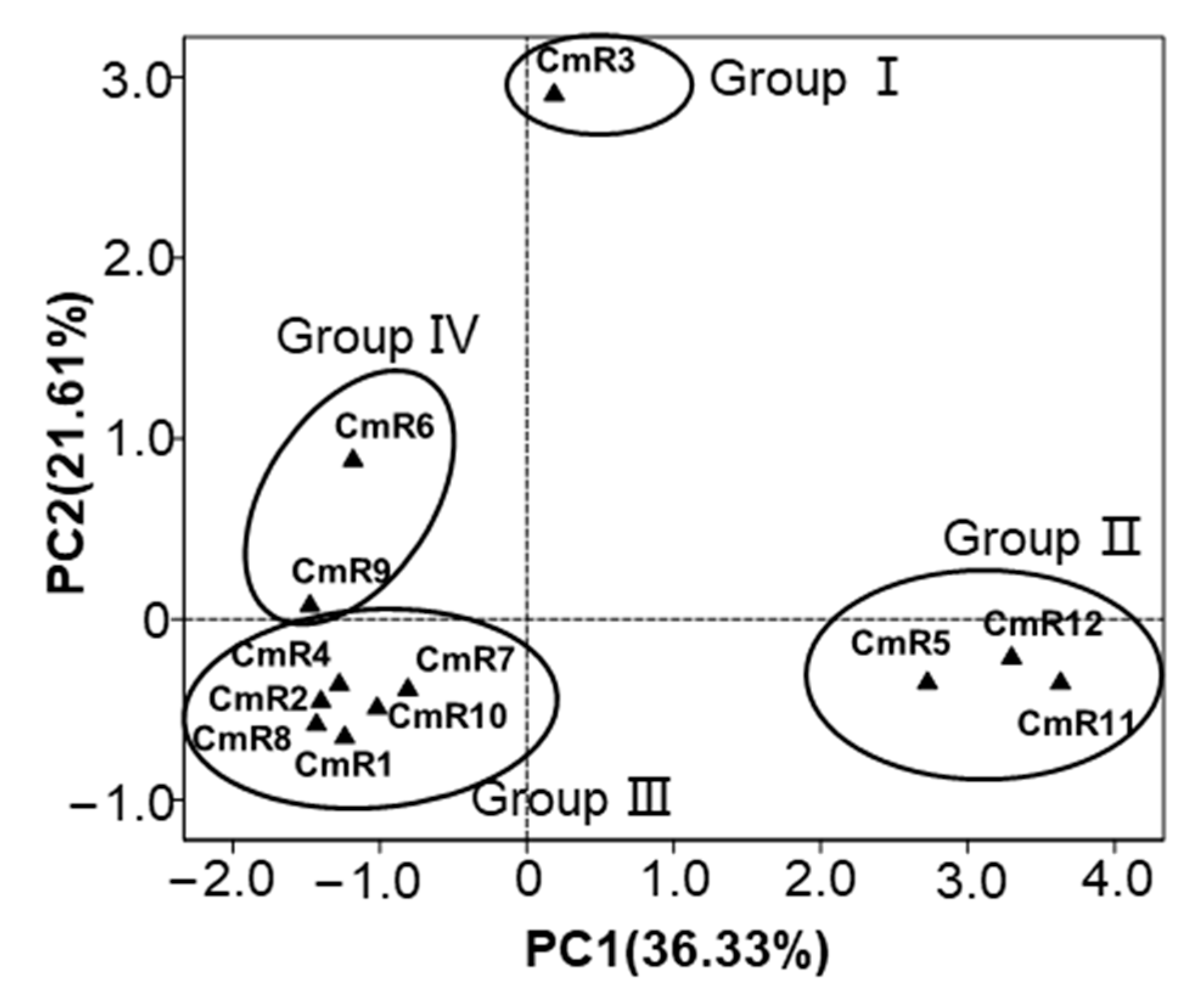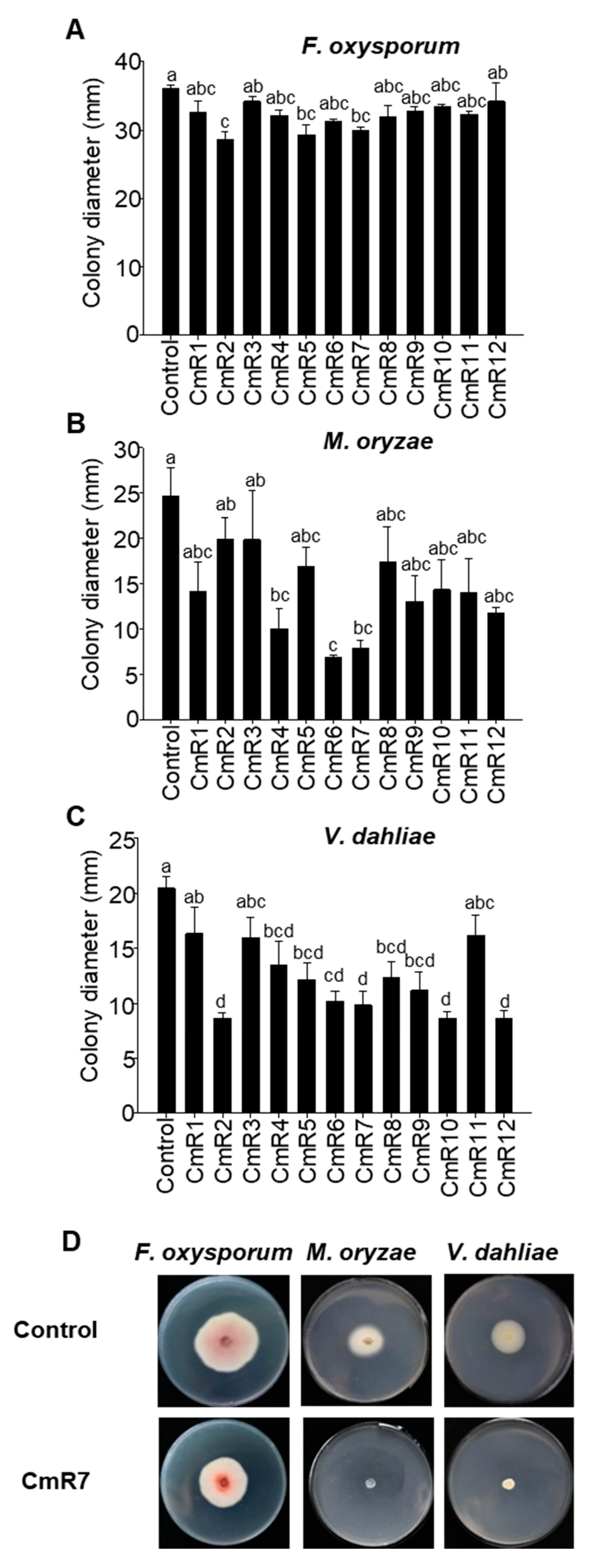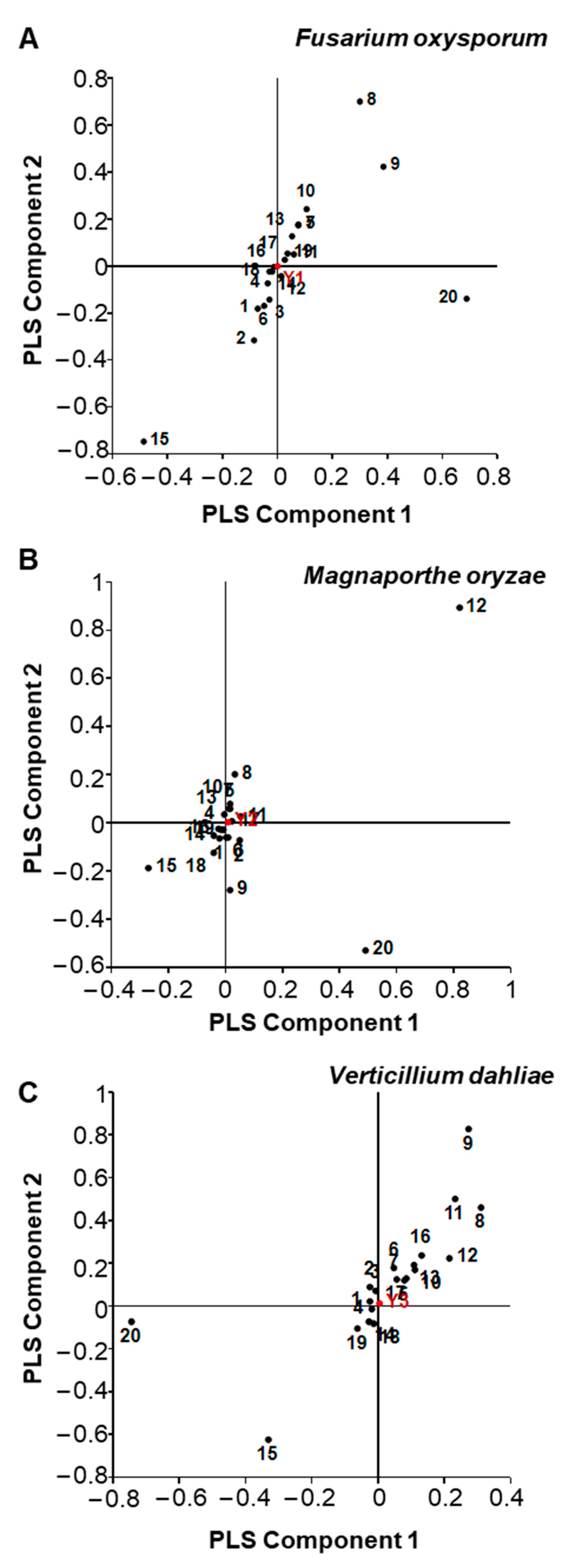Diverse Terpenoids and Their Associated Antifungal Properties from Roots of Different Cultivars of Chrysanthemum Morifolium Ramat
Abstract
1. Introduction
2. Results and Discussion
2.1. Chemical Composition of Terpenoids from C. morifolium Roots
2.2. Grouping of 12 Cultivars of C. morifolium Based on Principal Component Analysis
2.3. Antifungal Activity of C. morifolium Root Extracts
2.4. Partial Least Squares Analysis Based on the Antifungal Effect
3. Materials and Methods
3.1. Plants Material
3.2. Root Sample Preparation and Organic Extraction
3.3. GC-MS Analysis
3.4. Assessment of Antifungal Activity
3.5. Statistical Analysis
4. Conclusions
Supplementary Materials
Author Contributions
Funding
Conflicts of Interest
References
- Christenhusz, M.J.; Byng, J.W. The number of known plants species in the world and its annual increase. Phytotaxa 2016, 261, 201. [Google Scholar] [CrossRef]
- Van Dam, N.M.; Bouwmeester, H.J. Metabolomics in the Rhizosphere: Tapping into Belowground Chemical Communication. Trends Plant Sci. 2016, 21, 256–265. [Google Scholar] [CrossRef] [PubMed]
- Hiltpold, I.; Turlings, T.C.J. Manipulation of Chemically Mediated Interactions in Agricultural Soils to Enhance the Control of Crop Pests and to Improve Crop Yield. J. Chem. Ecol. 2012, 38, 641–650. [Google Scholar] [CrossRef] [PubMed]
- Van Dam, N.M. Belowground Herbivory and Plant Defenses. Annu. Rev. Ecol. Evol. Syst. 2009, 40, 373–391. [Google Scholar] [CrossRef]
- Baetz, U.; Martinoia, E. Root exudates: the hidden part of plant defense. Trends Plant Sci. 2014, 19, 90–98. [Google Scholar] [CrossRef]
- Luyen, N.T.; Tram, L.H.; Hanh, T.T.H.; Binh, P.T.; Dang, N.H.; Van Minh, C.; Dat, N.T.; Nguyen, H.D. Inhibitors of α-glucosidase, α-amylase and lipase from Chrysanthemum morifolium. Phytochem. Lett. 2013, 6, 322–325. [Google Scholar] [CrossRef]
- Wang, Y.; Xu, Z.; Wu, Y.; Li, M.; Pang, S.; Liang, Z.; Ni, Y. Effect of Weakly Basic Conditions on the Separation and Purification of Flavonoids and Glycosides from Chrysanthemum morifolium Tea. Molecules 2019, 24, 297. [Google Scholar] [CrossRef]
- Lin, L.-Z.; Harnly, J.M. Identification of the phenolic components of chrysanthemum flower (Chrysanthemum morifolium Ramat). Food Chem. 2010, 120, 319–326. [Google Scholar] [CrossRef]
- Chang, K.-M.; Kim, G.-H. Volatile aroma constituents of gukhwa (Chrysanthemum morifolium R.). Food Sci. Biotechnol. 2013, 22, 659–663. [Google Scholar] [CrossRef]
- Xue, H.; Jiang, Y.; Zhao, H.; Köllner, T.G.; Chen, S.; Chen, F.; Chen, F. Characterization of Composition and Antifungal Properties of Leaf Secondary Metabolites from Thirteen Cultivars of Chrysanthemum morifolium Ramat. Molecules 2019, 24, 4202. [Google Scholar] [CrossRef]
- Sun, H.; Zhang, F.; Chen, S.; Guan, Z.; Jiang, J.; Fang, W.; Chen, F. Effects of aphid herbivory on volatile organic compounds of Artemisia annua and Chrysanthemum morifolium. Biochem. Syst. Ecol. 2015, 60, 225–233. [Google Scholar] [CrossRef]
- Lee, H.-J.; Hwang, Y.-I.; Park, E.-J.; Choi, S.-U. Antihepatotoxic and Antigenotoxic Effects of Herb Tea Composed of Chrysanthemum morifolium Ramat. J. Korean Soc. Food Sci. Nutr. 2011, 40, 78–83. [Google Scholar] [CrossRef]
- Kuang, C.-L.; Lv, D.; Shen, G.-H.; Li, S.-S.; Luo, Q.-Y.; Zhang, Z. Chemical composition and antimicrobial activities of volatile oil extracted from Chrysanthemum morifolium Ramat. J. Food Sci. Technol. 2018, 55, 2786–2794. [Google Scholar] [CrossRef]
- Weigel, U.; Horn, W.; Hock, B. Endogenous auxin levels in terminal stem cuttings of Chrysanthemum morifolium during adventitious rooting. Physiol. Plant. 1984, 61, 422–428. [Google Scholar] [CrossRef]
- Shafaghat, A.; Sadeghi, H.; Oji, K. Composition and antibacterial activity of essential oils from leaf, stem and root of Chrysanthemum parthenium (L.) Bernh. from Iran. Nat. Prod. Commun. 2009, 4, 859–860. [Google Scholar] [CrossRef] [PubMed]
- Ramirez, A.M.; Stoopen, G.; Menzel, T.R.; Gols, R.; Bouwmeester, H.J.; Dicke, M.; Jongsma, M. Bidirectional Secretions from Glandular Trichomes of Pyrethrum Enable Immunization of Seedlings. Plant Cell 2012, 24, 4252–4265. [Google Scholar] [CrossRef]
- Manoharan, R.K.; Lee, J.-H.; Kim, Y.-G.; Kim, S.-I.; Lee, J. Inhibitory effects of the essential oils α-longipinene and linalool on biofilm formation and hyphal growth of Candida albicans. Biofouling 2017, 33, 1–13. [Google Scholar] [CrossRef]
- Li, P.; Chen, J.; Li, Y.; Zhang, K.; Wang, H. Possible mechanisms of control of Fusarium wilt of cut chrysanthemum by Phanerochaete chrysosporium in continuous cropping fields: A case study. Sci. Rep. 2017, 7, 15994. [Google Scholar] [CrossRef]
- Zhao, S.; Chen, X.; Deng, S.; Dong, X.; Song, A.; Yao, J.; Fang, W.; Chen, F. The Effects of Fungicide, Soil Fumigant, Bio-Organic Fertilizer and Their Combined Application on Chrysanthemum Fusarium Wilt Controlling, Soil Enzyme Activities and Microbial Properties. Molecules 2016, 21, 526. [Google Scholar] [CrossRef]
- Lee, K.; Singh, P.; Chung, W.-C.; Ash, J.; Kim, T.S.; Hang, L.; Park, S. Light regulation of asexual development in the rice blast fungus, Magnaporthe oryzae. Fungal Genet. Boil. 2006, 43, 694–706. [Google Scholar] [CrossRef]
- Chen, X.; Chen, H.; Yuan, J.S.; Köllner, T.G.; Chen, Y.; Guo, Y.; Zhuang, X.; Chen, X.; Zhang, Y.-J.; Fu, J.; et al. The rice terpene synthase gene OsTPS19 functions as an (S)-limonene synthase in planta, and its overexpression leads to enhanced resistance to the blast fungus Magnaporthe oryzae. Plant Biotechnol. J. 2018, 16, 1778–1787. [Google Scholar] [CrossRef] [PubMed]
- Klosterman, S.J.; Atallah, Z.K.; Vallad, G.E.; Subbarao, K.V. Diversity, Pathogenicity, and Management of Verticillium Species. Annu. Rev. Phytopathol. 2009, 47, 39–62. [Google Scholar] [CrossRef] [PubMed]
- Ashour, H.M. Antibacterial, antifungal, and anticancer activities of volatile oils and extracts from stems, leaves, and flowers of Eucalyptus sideroxylon and Eucalyptus torquata. Cancer Boil. Ther. 2008, 7, 399–403. [Google Scholar] [CrossRef] [PubMed]
- Bishop, P.; Sorochan, J.; Ownley, B.; Samples, T.J.; Windham, A.S.; Windham, M.T.; Trigiano, R.N. Resistance of Sclerotinia homoeocarpa to Iprodione, Propiconazole, and Thiophanate-Methyl in Tennessee and Northern Mississippi. Crop. Sci. 2008, 48, 1615–1620. [Google Scholar] [CrossRef]
- Garms, S.; Chen, F.; Boland, W.; Gershenzon, J.; Köllner, T.G. A single amino acid determines the site of deprotonation in the active center of sesquiterpene synthases SbTPS1 and SbTPS2 from Sorghum bicolor. Phytochemistry 2012, 75, 6–13. [Google Scholar] [CrossRef]
- Zhuang, X.; Köllner, T.G.; Zhao, N.; Li, G.; Jiang, Y.; Zhu, L.; Ma, J.; Degenhardt, J.; Chen, F. Dynamic evolution of herbivore-induced sesquiterpene biosynthesis in sorghum and related grass crops. Plant J. 2011, 69, 70–80. [Google Scholar] [CrossRef]
- Chen, H.; Li, G.; Köllner, T.G.; Jia, Q.; Gershenzon, J.; Chen, F. Positive Darwinian selection is a driving force for the diversification of terpenoid biosynthesis in the genus Oryza. BMC Plant Boil. 2014, 14, 239. [Google Scholar] [CrossRef]
- Robert, C.A.M.; Erb, M.; Duployer, M.; Zwahlen, C.; Doyen, G.R.; Turlings, T.C.J. Herbivore-induced plant volatiles mediate host selection by a root herbivore. New Phytol. 2012, 194, 1061–1069. [Google Scholar] [CrossRef]
- Vaughan, M.M.; Wang, Q.; Webster, F.X.; Kiemle, D.; Hong, Y.J.; Tantillo, D.J.; Coates, R.M.; Wray, A.T.; Askew, W.; O’Donnell, C.; et al. Formation of the Unusual Semivolatile Diterpene Rhizathalene by the Arabidopsis Class I Terpene Synthase TPS08 in the Root Stele Is Involved in Defense against Belowground Herbivory. Plant Cell 2013, 25, 1108–1125. [Google Scholar] [CrossRef]
- Ding, Y.; Huffaker, A.; Köllner, T.G.; Weckwerth, P.; Robert, C.A.M.; Spencer, J.; Lipka, A.E.; Schmelz, E.A. Selinene Volatiles Are Essential Precursors for Maize Defense Promoting Fungal Pathogen Resistance. Plant Physiol. 2017, 175, 1455–1468. [Google Scholar] [CrossRef]
- Rodríguez, A.; Andrés, V.S.; Cervera, M.; Redondo, A.; Alquezar, B.; Shimada, T.; Gadea, J.; Rodrigo, M.; Zacarias, L.; Palou, L.; et al. Terpene Down-Regulation in Orange Reveals the Role of Fruit Aromas in Mediating Interactions with Insect Herbivores and Pathogens. Plant Physiol. 2011, 156, 793–802. [Google Scholar] [CrossRef] [PubMed]
Sample Availability: Samples of the root extracts from 12 cultivars are available from the authors. |





| Code | Cultivar | Collection Locality |
|---|---|---|
| CmR1 | ‘Hang Bai Ju’ | Nanjing, Jiangsu province, China |
| CmR2 | ‘Xiao Xiang Ju’ | Nanjing, Jiangsu province, China |
| CmR3 | ‘Shi Huang Ju’ | Nanjing, Jiangsu province, China |
| CmR4 | ‘E Pang Gong’ | Nanjing, Jiangsu province, China |
| CmR5 | ‘Da Yang Ju’ | Nanjing, Jiangsu province, China |
| CmR6 | ‘Huang Ju’ | Nanjing, Jiangsu province, China |
| CmR7 | ‘Xiao Huang Ju’ | Nanjing, Jiangsu province, China |
| CmR8 | ‘Wan Gong Ju’ | Nanjing, Jiangsu province, China |
| CmR9 | ‘Xiu Ning Yao Ju’ | Nanjing, Jiangsu province, China |
| CmR10 | ‘Bai Xiang Li’ | Nanjing, Jiangsu province, China |
| CmR11 | ‘She Yang Hong Xin Ju’ | Nanjing, Jiangsu province, China |
| CmR12 | ‘Zao Hua’ | Nanjing, Jiangsu province, China |
| NO. | Compounds | Retention Index | Concentration (μg g−1 Fresh Weight) | |||||||||||
|---|---|---|---|---|---|---|---|---|---|---|---|---|---|---|
| CmR1 | CmR2 | CmR3 | CmR4 | CmR5 | CmR6 | CmR7 | CmR8 | CmR9 | CmR10 | CmR11 | CmR12 | |||
| Monoterpenes | ||||||||||||||
| 1 | α-pinene * | 939 | 1.32 ± 0.15 a | ND | ND | ND | 15.34 ± 1.77 | ND | 15.11 ± 1.73 | ND | ND | ND | 14.70 ± 2.23 | 16.90 ± 2.28 |
| 2 | α-fenchene | 950 | ND b | 11.76 ± 1.87 | ND | ND | 27.64 ± 2.29 | ND | ND | ND | ND | ND | 32.04 ± 4.12 | 33.95 ± 2.68 |
| 3 | β-pinene * | 981 | ND | ND | ND | ND | 17.84 ± 2.26 | ND | 4.03 ± 1.05 | ND | ND | 1.52 ± 0.30 | 17.14 ± 2.19 | 19.45 ± 2.34 |
| 4 | para-cymene | 1035 | ND | ND | ND | ND | 4.40 ± 0.32 | ND | 8.46 ± 1.91 | ND | ND | ND | 4.95 ± 0.76 | 5.15 ± 0.61 |
| Sesquiterpenes | ||||||||||||||
| 5 | Silphinene | 1353 | ND | ND | 19.55 ± 0.62 | ND | ND | 8.52 ± 0.31 | ND | 1.85 ± 0.15 | 5.24 ± 0.71 | ND | ND | ND |
| 6 | α-longipinene | 1361 | 2.37 ± 0.15 | 1.75 ± 0.35 | 1.71 ± 0.13 | 2.28 ± 0.36 | 17.13 ± 1.27 | ND | 8.14 ± 0.86 | ND | ND | ND | 23.01 ± 2.76 | 18.38 ± 1.91 |
| 7 | modephene | 1391 | ND | ND | 20.73 ± 0.51 | ND | ND | 9.41 ± 0.30 | ND | ND | 4.99 ± 0.52 | ND | ND | ND |
| 8 | α-isocomene | 1396 | ND | ND | 80.87 ± 2.33 | ND | ND | 41.03 ± 1.26 | ND | ND | 22.98 ± 2.99 | ND | ND | ND |
| 9 | β-elemene | 1399 | 53.40 ± 7.66 | 2.01 ± 0.47 | ND | 47.12 ± 2.24 | 55.20 ± 3.01 | 12.00 ± 1.48 | ND | 2.38 ± 0.65 | 45.63 ± 5.22 | 81.06 ± 14.22 | 84.53 ± 6.83 | 42.40 ± 0.83 |
| 10 | β-isocomene | 1418 | ND | ND | 27.87 ± 0.76 | ND | ND | 12.50 ± 0.44 | ND | ND | 7.54 ± 0.92 | ND | ND | ND |
| 11 | (E)-β-caryophyllene * | 1431 | 10.93 ± 1.64 | 10.00 ± 0.80 | 35.58 ± 0.56 | 7.86 ± 1.13 | 27.12 ± 0.39 | 18.05 ± 0.90 | 6.93 ± 0.40 | 11.50 ± 0.56 | 11.15 ± 0.67 | ND | 37.53 ± 2.77 | 32.12 ± 4.45 |
| 12 | (E)-β-farnesene | 1464 | 112.23 ± 8.31 | 246.48 ± 17.39 | 175.81 ± 12.22 | 108.22 ± 11.61 | 131.77 ± 12.88 | 68.36 ± 6.21 | 66.56 ± 8.69 | 258.40 ± 8.14 | 207.81 ± 30.94 | 127.94 ± 11.08 | 194.25 ± 9.79 | 133.47 ± 9.01 |
| 13 | β-copaene | 1474 | 5.80 ± 1.64 | ND | 12.74 ± 0.37 | 7.56 ± 0.85 | ND | 6.85 ± 0.93 | ND | ND | ND | ND | ND | ND |
| 14 | δ-bisabolene | 1489 | 2.54 ± 0.77 | ND | ND | ND | ND | 14.85 ± 1.17 | ND | ND | ND | ND | ND | ND |
| 15 | Neollocimene | 1495 | 5.11 ± 0.55 | 6.81 ± 1.21 | 11.67 ± 0.28 | ND | 15.97 ± 0.61 | 9.99 ± 0.54 | 133.61 ± 14.34 | 11.46 ± 1.98 | 4.26 ± 1.20 | 4.31 ± 0.38 | 18.18 ± 1.04 | 16.40 ± 2.53 |
| 16 | α-zingberene | 1504 | 22.95 ± 2.12 | 3.56 ± 0.80 | 5.49 ± 0.80 | 6.27 ± 1.32 | 13.19 ± 1.02 | 20.38 ± 0.97 | 7.77 ± 1.16 | 18.88 ± 0.70 | 10.62 ± 0.47 | ND | 17.13 ± 1.30 | 10.44 ± 1.45 |
| 17 | β-bisabolene * | 1518 | 5.43 ± 0.78 | 4.84 ± 0.58 | 8.25 ± 1.63 | 6.45 ± 0.89 | 9.50 ± 0.35 | 5.76 ± 0.73 | ND | 9.81 ± 0.22 | 3.77 ± 0.74 | 4.52 ± 0.76 | 11.49 ± 0.88 | 10.53 ± 0.82 |
| 18 | β-sesquiphellandrene | 1533 | ND | 6.08 ± 0.87 | 19.05 ± 2.05 | 4.95 ± 0.73 | 21.17 ± 2.15 | 49.39 ± 2.85 | 12.45 ± 2.40 | 53.40 ± 5.34 | 23.34 ± 2.27 | 9.11 ± 0.57 | 34.19 ± 4.01 | 18.65 ± 2.96 |
| 19 | γ-costol | 1760 | ND | ND | ND | ND | ND | 3.91 ± 1.34 | ND | ND | ND | 10.84 ± 0.67 | ND | ND |
| Diterpene | ||||||||||||||
| 20 | unidentified diterpene | 2298 | 57.39 ± 7.58 | 93.93 ± 23.83 | 69.13 ± 8.21 | 58.66 ± 11.25 | 229.37 ± 16.19 | 16.99 ± 0.64 | 20.94 ± 8.79 | 28.38 ± 12.90 | 19.58 ± 5.54 | 285.52 ± 39.55 | 242.43 ± 24.56 | 253.68 ± 32.81 |
© 2020 by the authors. Licensee MDPI, Basel, Switzerland. This article is an open access article distributed under the terms and conditions of the Creative Commons Attribution (CC BY) license (http://creativecommons.org/licenses/by/4.0/).
Share and Cite
Zhang, K.; Jiang, Y.; Zhao, H.; Köllner, T.G.; Chen, S.; Chen, F.; Chen, F. Diverse Terpenoids and Their Associated Antifungal Properties from Roots of Different Cultivars of Chrysanthemum Morifolium Ramat. Molecules 2020, 25, 2083. https://doi.org/10.3390/molecules25092083
Zhang K, Jiang Y, Zhao H, Köllner TG, Chen S, Chen F, Chen F. Diverse Terpenoids and Their Associated Antifungal Properties from Roots of Different Cultivars of Chrysanthemum Morifolium Ramat. Molecules. 2020; 25(9):2083. https://doi.org/10.3390/molecules25092083
Chicago/Turabian StyleZhang, Kaige, Yifan Jiang, Hongwei Zhao, Tobias G. Köllner, Sumei Chen, Fadi Chen, and Feng Chen. 2020. "Diverse Terpenoids and Their Associated Antifungal Properties from Roots of Different Cultivars of Chrysanthemum Morifolium Ramat" Molecules 25, no. 9: 2083. https://doi.org/10.3390/molecules25092083
APA StyleZhang, K., Jiang, Y., Zhao, H., Köllner, T. G., Chen, S., Chen, F., & Chen, F. (2020). Diverse Terpenoids and Their Associated Antifungal Properties from Roots of Different Cultivars of Chrysanthemum Morifolium Ramat. Molecules, 25(9), 2083. https://doi.org/10.3390/molecules25092083








